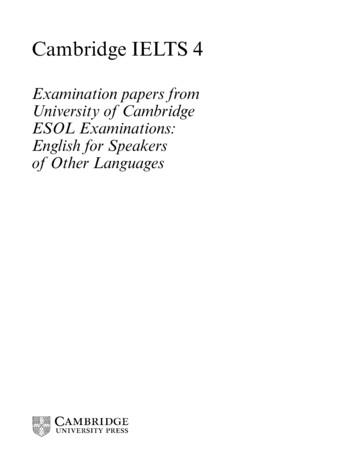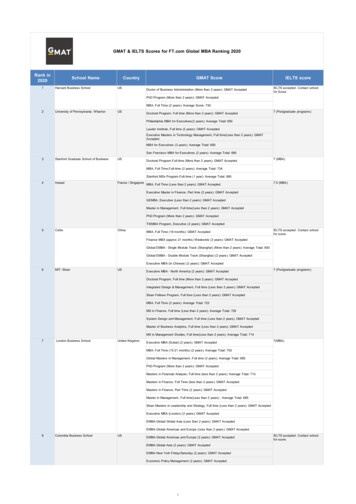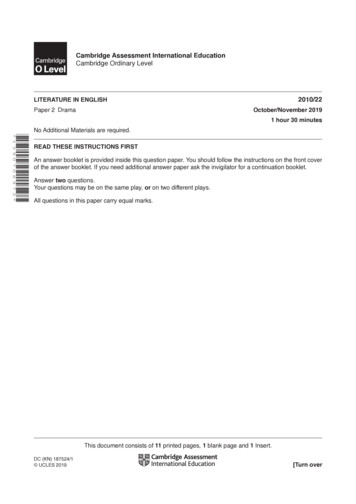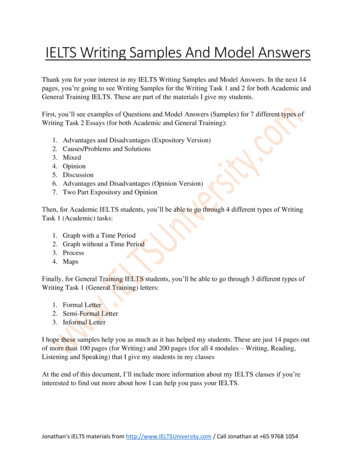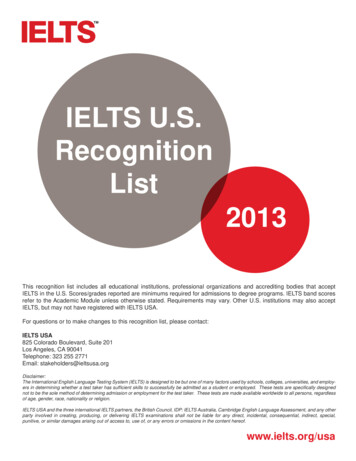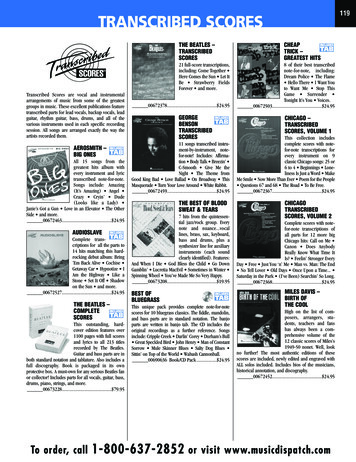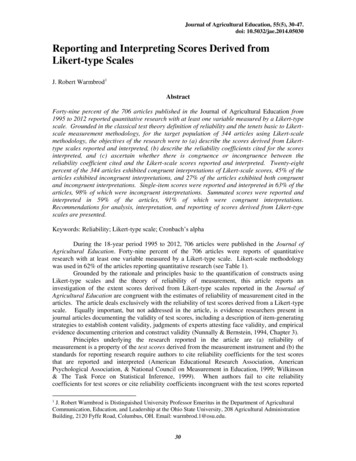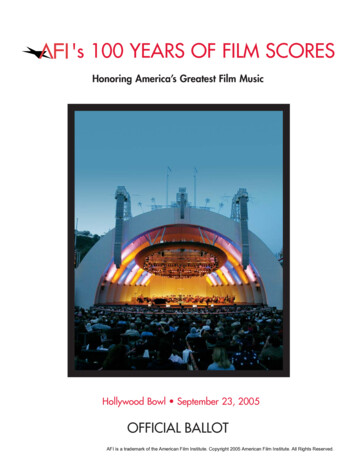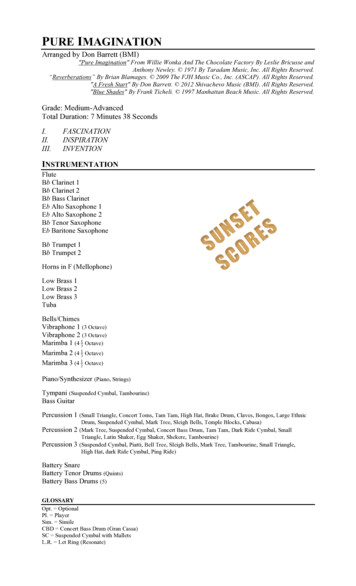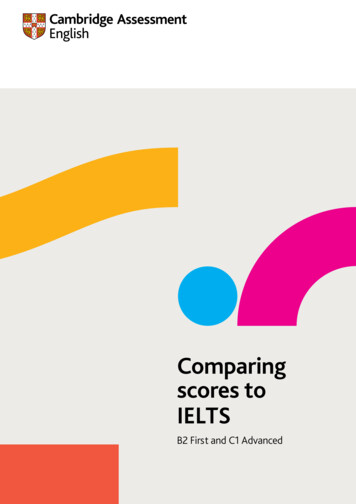
Transcription
Comparingscores toIELTSB2 First and C1 Advanced
Comparing scores to IELTSB2 First is targeted at Level B2 on the Common European Framework of Reference (CEFR)*. This qualificationdemonstrates that candidates have the language skills to live and work independently in an English-speakingcountry or study on courses taught in English at pre-degree level.C1 Advanced is targeted at Level C1 on the CEFR. It is an in-depth qualification which shows that candidateshave the high-level English language skills needed to study in English at undergraduate or postgraduate level,and to work and live in an English-speaking environment.Each Cambridge English Qualification is focused on a specific CEFR level. For exams from A2 Key to C2 Proficiency,including Business, we also report achievement above and below target level. For Young Learners, we reportachievement at the target level and the level below.Common EuropeanFramework ofReference (CEFR)MultilevelTestsCambridgeEnglishScaleGeneral and higher roficiency2108.58.0200C1190C1 BusinessHigherINDEPENDENTB2 BusinessVantage160B17.06.5B2First1706.0200B1 10090908080*IELTS is mapped to, but does not report on the Cambridge English ScaleB2 First and C1 Advanced both report on theCambridge English Scale, a single range of scores usedto report results for Cambridge English Qualifications,as shown in the diagram above.Many institutions need to know how CambridgeEnglish Scale scores achieved in B2 First andC1 Advanced compare with IELTS** band scores.The table opposite shows this relationship.IELTSband scoreCambridge EnglishScale score7.51917.01856.51766.01695.51625.0154* F urther information about the Common European Framework of Reference (CEFR) can be found atcambridgeenglish.org/cefr.** I ELTS is jointly owned by British Council, IDP: IELTS Australia and Cambridge Assessment English.2
Using B2 First and C1 Advanced scoresEvery successful B2 First and C1 Advanced candidate receives a Statement of Results, which contains thefollowing information:1. Score – their overall score on the Cambridge English Scale.2. Candidate profile – their score on the Cambridge English Scale for each of the four skills(reading, writing, listening and speaking) and for Use of English.3. Grade – relates to the score and is a letter grade from A to C.4. Candidates also receive an overall level on the CEFR.Candidates who have secured scores between 160 and 172 on B2 First are awarded grade C on that exam andare placed at Level B2 on the CEFR.Candidates who have secured a C1 Advanced grade C, having scored between 180 and 192 on the CambridgeEnglish Scale, are at Level C1 of the CEFR and can be expected to be comparable in ability with candidateswho have secured 6.5 or 7.0 in IELTS. Candidates who have secured scores between 180 and 190 in B2 First areawarded a grade A for that exam. They are also placed at Level C1 of the CEFR. However, the breadth of coverageof B2 First at this level is limited and very careful consideration would be needed before accepting scores on B2First as comparable to IELTS scores of 7.0. Candidates who have secured scores of 160 to 179 on C1 Advanced areplaced at Level B2 and may be expected to be comparable to candidates who have secured 5.5 or 6.0 in IELTS.Where institutions have specified a minimum IELTS requirement of 5.5, reference may be made to the Scale score,and a minimum requirement of 162 specified on either exam. If, say, the requirement is Band 6.0 overall but witha minimum score of 5.5 in any skill, then an overall score of 169 may be specified with minimum scores of 162in Listening, Reading, Writing and Speaking. Where an overall requirement of IELTS Band 7.0 has been set, then ascore of 185 should be specified, but as explained above, it may be appropriate to specify that the score has beenobtained on C1 Advanced rather than B2 First.Example requirementsIELTS requirementsCambridge English requirementsOverall IELTS band score 5.5Overall Cambridge English Scale score of 162,achievable in B2 First or C1 Advanced.Overall IELTS band score 6.5No less than 6.0 in any skillOverall Cambridge English Scale score of 176 fromC1 Advanced. No less than 169 in any paper.Cambridge Assessment English Comparing scores to IELTS3
How we compared B2 First scores,C1 Advanced scores and IELTS performancesWe are responsible for the production of Cambridge English Qualifications and IELTS. All our qualifications andtests are built to a common underlying scale. Rasch analysis (Rasch 1960, 1980) is used to assess the relativedifficulty of every Reading or Listening item, placing each on a common scale, regardless of the exam for whichthey are intended (Jones 2001). All items are kept in a database with information about their measurementcharacteristics. This permits the creation of multiple versions of an exam to a specific level and range of difficulty,and establishes the relationship between different exams. We have also published Common Scales for Writing andSpeaking, based on qualitative analysis of the features of these skills at different levels (Hawkey and Barker 2004;Galaczi, ffrench, Hubbard and Green 2011; Lim 2012).Nevertheless, there are challenges associated with linking and comparing exams, as discussed in severalCambridge Assessment English publications (Milanovic 2009; Shaw and Weir 2007; Taylor 2004; Taylor and Jones2006). Exact equivalences cannot always be demonstrated, only broad comparability. Lim, Geranpayeh, Khalifaand Buckendahl (2013) provide further discussion of the conceptual and practical issues that attend standardsetting. It is better not to rely on a single source of evidence but to build up a cumulative case based ona range of data.Since 1999, several studies have helped refine our understanding of the relationship between these scores.One of the earliest, part of the Association of Language Testers in Europe’s Can Do project (Jones 2001), showedthat, in terms of candidates’ self-perception, candidates securing Band 6 felt comfortable with a similar rangeof activities as candidates securing a B2 First grade C, while candidates securing Band 7 thought themselvescomparable to candidates securing a C1 Advanced grade C. There is a steady progression in self-ratings acrossIELTS bands (with the exception of Band 5).Can Do self-ratings and gradesMean self-rating (logits)765432104CBAB2 FirstB2 FirstB2 FirstCBAC1 Advanced C1 Advanced C1 Advanced456789IELTSIELTSIELTSIELTSIELTSIELTS
In 2009, we undertook to benchmark Level C1 as represented by C1 Advanced against IELTS scores. For thisexercise an empirical validation study was undertaken, where registered IELTS candidates were invited to alsotake C1 Advanced, and registered Advanced candidates were invited to take IELTS, and their scores compared.This counterbalanced design accounted for preparation or motivation-related effects on one exam or theother. As C1 Advanced targets the higher end of the IELTS candidature population, participants’ performancewas on average higher than that of the global IELTS candidature, as expected. Correlations between scores onthe two exams were calculated to see how related the two tests are. The correlations between the differentparts of the two exams are generally moderate, whereas the correlation for the overall scores is, as might beexpected, stronger.To compare results on the two exams, the equipercentile linking method was used, and pre-smoothing usingthe polynomial log-linear method (Holland and Thayer 2000) was employed to increase the precision of thelinking. This method was adopted because indices are available for evaluating goodness of fit and appropriatenessof the linking (Kolen and Brennan 2004). Because smoothing resulted in C1 Advanced scores that were notintegers, linear interpolation was used to determine IELTS raw marks that corresponded to CEFR Levels B2, C1 andC2 on each of the four skills, and standard conversion tables were used to express the outcomes in terms of thenine-band IELTS scale. Classification consistency between the two exams on the three levels and across thefour skills averaged 80%.In the meantime, the IELTS partners had approached Chad Buckendahl of Alpine Testing Solutions to lead astandard-setting study aligning IELTS bands to the CEFR levels. The standard-setting study involved 19 panellistsusing two different standard-setting methods for the four papers that comprise IELTS. For Speaking and Writing,a modification of the Analytical Judgment method (Plake and Hambleton 2000) was used. Panellists were askedto read samples of writing and view samples of speaking, and to classify each into appropriate CEFR levels,which was subsequently refined to identify performances at the border of each level. These judgements werethen replaced by the original score that those performances received to arrive at the cut score. For Listening andReading, the Yes/No variation of the Angoff (1971) method (Impara and Plake 1997) was adopted. This standardsetting project is discussed further in Lim, Geranpayeh, Khalifa and Buckendahl (2013).Our advice as to the alignment of C1 Advanced scores and IELTS bands is therefore based on the results of theexternal validity study comparing IELTS and C1 Advanced performances, with supporting evidence drawn fromthe 2009 IELTS standard-setting project and earlier studies.Cambridge Assessment English Comparing scores to IELTS5
How was the Cambridge English Scale produced?There is a well-established link between our qualifications and the CEFR, and the current score-reporting systemreflects this. Results on the Cambridge English Scale are reached by applying the same underlying methodology,but the link between our qualifications and the CEFR is refined. This brings a greater clarity and transparency toscore meanings and facilitates easy comparisons between different exams.The Scale was developed according to the well-documented and researched links between performance ondifferent tests (using data from millions of candidates) and the processes by which we define and maintainstandards.These processes vary slightly for the different components and are described below.Writing and Speaking componentsWriting and Speaking components are marked by trained, standardised examiners according to a set ofanalytic scales, covering a range of assessment criteria. The assessment criteria are linked to the CEFR and forman overlapping ‘ladder’. The criteria for each level are the same across all our exams. For example, the criteriarequired to meet CEFR Level B2 are identical for both B2 First and C1 Advanced.B2 FirstC1 AdvancedExample assessment criteriaC2Uses the conventions of the communicativetask with sufficient flexibility to communicatecomplex ideas in an effective way, holding thetarget reader’s attention with ease, fulfilling allcommunicative purposes.C1Uses the conventions of the communicativetask effectively to hold the target reader’sattention and communicate straightforwardand complex ideas as appropriate.B2Uses the conventions of the communicativetask to hold the target reader’s attention andcommunicate straightforward ideas.B1Uses the conventions of the communicativetask in generally appropriate ways tocommunicate straightforward ideas.Marks are awarded according to the assessment criteria, and are combined to provide the total mark for thecomponent. Because both the assessment criteria and the Cambridge English Scale are linked to the CEFR,the Scale score for the component can be determined from this total mark.This process ensures that candidates who demonstrate the same level of ability (no matter which exam is taken)are awarded the same Cambridge English Scale score.For example:Two candidates at low CEFR Level B2 sit our exams – one sits B2 First, the other C1 Advanced. They bothjust meet the criteria for Level B2 in the Writing paper and are awarded marks for the component accordingly.Although the raw marks across the two exams are different, the candidates are both awarded a Scale scoreof 160 for the Writing component, as they have demonstrated the same level of ability.6
Reading, Listening and Use of English componentsReading, Listening and Use of English components contain a series of items which are marked as either corrector incorrect. We use Rasch analysis (Rasch 1960, 1980) to ensure a consistent standard is applied in the gradingof objectively marked components, accounting for differences in difficulty between them. This is achievedby calibrating the difficulty of all the items in a given test onto the same scale. This calibration allows us todetermine the raw marks for each specific test paper that represent a predetermined level of ability – the standardneeded to achieve a particular grade or level. Furthermore, the scales used for each test are linked to adjacentlevels, meaning that these standards can be compared and linked across levels.By a process of standard setting, these defined ability levels are linked to CEFR thresholds, meaning that the sameprocess of mapping can take place as with the Writing and Speaking components.Linking exams to each other and to the CEFRThe relationship between our qualifications and the CEFR is long standing and well documented. The relationshipcan be classified in terms of the historical perspective, the conceptual perspective and the empirical perspective.Discussions of all three perspectives, plus full references and links to key papers can be found on our website ness-for-purpose.However, test alignment is not a one-off project – validation is an ongoing process which requires regularre-evaluation and confirmation that existing alignments continue to hold.To this end, and with the introduction of the Cambridge English Scale in mind, a
IELTS requirements Cambridge English requirements Overall IELTS band score 5.5 Overall Cambridge English Scale score of 162, achievable in B2 First or C1 Advanced. Overall IELTS band score 6.5 No less than 6.0 in any skill Overall Cambridge English Scale score of 176 from C1 Advanced. No less than 169 in any paper. 4 How we compared B2 First scores, C1 Advanced scores and IELTS performances We .
